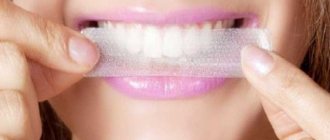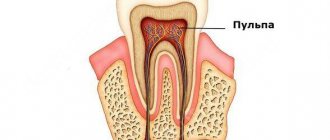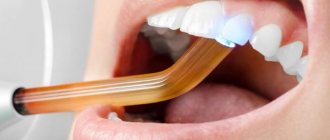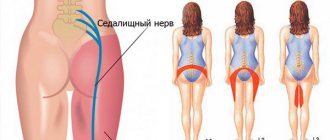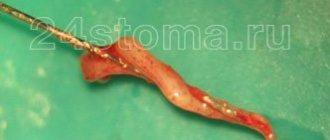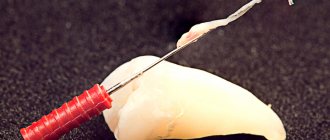If caries is not cured in time, and there is a deep carious lesion, the only way out is to remove the dental nerve. As caries develops, microorganisms violate the integrity of the enamel, as a result of which the nerve is exposed and reacts to any influence with unbearable pain.
Depulpation (nerve removal) is a modern way to preserve a unit of dentition without implantation.
When nerve removal is indispensable
In modern dental practice, both complete and partial resection are used. Indications for the procedure:
- deep carious tissue damage;
- chronic pulpitis (including asymptomatic);
- bactericidal infection spread by the apex of the tooth root;
- the presence of an extensive pulp area, the threat of developing periodontitis or transition to periodontitis;
- trauma leading to nerve exposure and tooth destruction;
- the need to correct a medical error;
- the need for prosthetics with low crowns.
Unbearable pain can also be an indication for depulpation.
The dentist will never prescribe such a serious intervention as long as it is possible to save the tooth.
Important : problematic “eights” when affected by caries, as a rule, are removed. This is due to the location of the “wisdom” teeth at the end of the dentition, which makes cleaning them from plaque and stone and filling the canals very problematic. Indications for removal are also the wrong direction of eruption, displacement of the dentition, malocclusion, and the development of pulpitis.
In what situations should a nerve not be removed?
We are talking not only about contraindications, but also about cases in which the pulp can be preserved. The procedure is not performed if the patient has:
- any infectious disease;
- one of the forms of stomatitis;
- psychoemotional disorders;
- acute pathologies of the heart and blood vessels;
- unsatisfactory condition of the oral cavity with suppuration and inflammation.
The nerve is preserved if it is not subject to inflammation due to caries or other pathologies and injuries. The dentist’s task is to save the pulp and remove it only in case of emergency.
Important: you cannot endure a toothache and hope that the pain in your nerve will stop. Inflammation can become chronic and show almost no effect, but any provoking factor will affect the development of a purulent abscess. In this case, the minimal consequence will be tooth loss, and the possible consequence will be the spread of infection to other tissues.
What is the dental nerve called?
In dentistry, the dental nerve, or pulp, is a complex structure - an interweaving of nerves and vessels located inside the root and crown of the tooth and responding to external stimuli.
Depulpation allows you to save the damaged tooth, but has negative consequences:
- Since the pulp acts as a barrier to infections, removing the nerve deprives the tooth of the necessary level of blood supply and mineralization, which shortens its “life.”
- A tooth deprived of a nerve loses sensitivity, the enamel becomes more fragile and faded, and the strength of the tooth decreases.
Delete or restore?
In many cases, the decision to try to save or remove a problematic tooth is made by the patient himself. The desire of people to preserve a tooth at any cost is understandable and resonates with dentists, armed with the most modern and advanced methods of tooth preservation. However, some patients easily part with dental problems, explaining this action by lack of time for dental treatment or high prices for proper restorative dental treatment. I would like to remind such patients that if one tooth is removed and an implant is not installed in its place, this means inevitably provoking a gradual change in the entire dental system. Having saved money and time on the treatment of one tooth, you will have to face the need for implantation or prosthetics in the future, which require even greater costs. Family dentistry on Paveletskaya offers the patient to make the right choice, wanting to fight as hard as possible to preserve your teeth and at the same time having everything necessary for the successful restoration of problem teeth.
Stages of the depulpation process
- X-ray – necessary to assess the condition of the pulp, the number, length and branching of the canals to be filled.
- Anesthesia - local or complete anesthesia completely covers the issue of pain when removing a nerve (it doesn’t hurt!). At the same time, general anesthesia is used relatively rarely - when treating children, with true dental phobia, etc.
- Installation of a rubber dam - a latex film for insulating a tooth. A modern solution to improve the dentist’s working conditions and protect against the possible spread of microorganisms through saliva.
- The actual removal of the nerve is the excision of tissues affected by caries, opening the pulp chamber and extracting the nerve with a special instrument (pulpoextractor). In modern practice, this is a careful cutting of the pulp without affecting sensitive areas.
- Installation of a temporary filling (for a period of 1-2 weeks).
- Control x-ray.
If the x-ray and the condition of the tooth are satisfactory, after the control period a permanent filling is installed.
How long can a tooth with a removed nerve “last”?
The service life of a pulpless tooth is influenced by a number of factors:
- Conditions of care provided to the oral cavity and teeth;
- Quality of nutrition and degree of hardness of products;
- Efficiency of treatment and tooth restoration;
- Regular visits to the dental clinic.
- High-quality prevention of dental caries.
You can extend the service life of a chewing element without a nerve using comprehensive measures:
- minimize drinks that have a high acid content (citrus juices, carbonated drinks, etc.);
- do not eat too hard foods that can cause tooth fracture;
- include in your daily diet foods rich in iron, phosphorus, calcium and other microelements necessary for dental health;
- take vitamin-mineral complexes in autumn and spring;
- Avoid using toothpastes with a whitening effect. It is recommended to replace them with pastes for sensitive teeth.
The comprehensive application of the recommendations will extend the life of a tooth from which the nerve has been removed. Otherwise, its destruction will begin after 1-2 years and procedures for its treatment and restoration will be powerless. As a rule, such chewing elements must be removed.
Depulpation before prosthetic crowns
Depulpation is unconditional if there is serious tooth decay. It is preferable to remove the dental nerve during prosthetics in the following cases:
- The size of the teeth determines the low position of the crown (too small or short teeth);
- The inclination of the prosthetic tooth is from 15°;
- Increased sensitivity of teeth;
- According to aesthetic requirements.
The need to remove the dental nerve during prosthetics is dictated by deep removal of the top layer of dental tissue: if the doctor is not sufficiently qualified, heating or touching the nerve can cause an attack of unbearable pain. However, cases of nerve-sparing crown installation also occur in modern dental practice.
If over time the nerve under the crown becomes bothersome, it is possible to remove the pulp through the top of the crown and fill the hole after removal.
The danger of such a procedure is associated with the risk of complications in the future due to surgery on the exposed dental nerve.
An alternative restoration method is the use of ceramic inlays.
Inlays are most often made of ceramic. When no more than 70% of the tissue in a tooth is destroyed, an inlay is an excellent method of restoration, which can also serve for many, many years. In the example below, we see that the teeth on the left were restored with light-rejecting fillings, and the teeth on the right were restored with inlays. This photo was taken three years after restoration. The inlays were made by the chief physician of the Family Dental Clinic, S.V. Tsukor. The fillings were not made in our center.
You can see that the fillings have areas of darkening, peeling and other defects, but they retain their functionality and do not fall out. The tabs on the right are in perfect condition even after years of use.
About dental anesthesia
Standard dental practice is an injection of anesthetic; Taking tablet analgesics before going to the dentist is not recommended, as it leads to a decrease in the effectiveness of anesthesia (usually the effect of an anesthetic injection is 45 minutes). For patients suffering from a fear of injections, it is possible to use paste anesthesia, which has a similar effect.
The choice of anesthesia is up to the dentist; Taking into account the individual pain sensitivity threshold of each patient, the standard dose is sometimes doubled or even tripled. With proper selection of an anesthetic, discomfort during the procedure for the patient is excluded.
Prevention of dead teeth
The main measures aimed at preventing the appearance of dead teeth are:
- regular visits to dental clinics (at least twice a year);
- daily brushing of teeth (the procedure should be carried out at least twice a day, the duration of brushing should be more than 3 minutes);
- prevention of pulpitis, caries, periodontitis;
- using toothpicks and dental floss after meals;
- regular rinsing of the mouth with special solutions;
- competent selection of toothpastes and brushes;
- thorough cleaning of the inner surface of the cheeks, palate, tongue and other areas of the oral cavity that serve as places where pathogenic microbes accumulate;
- timely treatment of caries and other dental diseases.
Compliance with the above recommendations will not only prevent the appearance of dead teeth, but also preserve a beautiful, healthy, snow-white smile for a long time.
Why can a tooth hurt after pulp removal?
This often happens: the nerve has already been removed, but the pain remains. Such manifestations are acceptable in the first 3-4 days as a natural reaction of the body (for example, to clenching the jaws or to temperature stimuli).
Other causes of toothache after pulp removal:
- Careless cleaning of the canals, preservation and intensification of the inflammatory process due to incomplete removal of tissue damaged by caries.
- Using during the procedure a pulp extractor that is not suitable for the size of the canal or improper handling of the instrument.
- Broken dental instrument, retention of its remains in the upper part of the root (such a medical error leads to the need to remove the tooth).
- The occurrence of a secondary inflammatory process in the treated canals (residual pulpitis) occurs against the background of an incompletely removed nerve.
- Allergic reaction of the patient to the filling material.
The main causes of dead teeth
The main causes of tooth depulpation are usually divided into:
- infectious,
- and traumatic.
Traumatic causes
Trauma to teeth often leads to pulp separation and subsequent death. In addition, under the influence of external factors, the crown part of the tooth, which protects the sensitive neurovascular bundle from irritants, can chip. In both situations described, one of the most important stages of treatment is the depulpation procedure.
Infectious causes
The most common infectious causes of dead teeth are:
- deep caries;
- periodontitis;
- pulpitis.
Deep caries
With deep caries, severe damage to dental tissue occurs. The treatment program for this disease involves complete excision of the damaged areas, resulting in thinning or destruction of the wall that protects the pulp from external influences. In order to prevent infectious damage to the neurovascular bundle, its preventive removal is performed.
Pulpitis and periodontitis
Inflammation of soft dental tissues that occurs during pulpitis or periodontitis cannot be treated with conservative methods. In the absence of timely therapy, the neurovascular bundle dies and begins to decompose, and the pulp chamber turns into a focus of infection. The death of the pulp entails a rapid darkening of the tooth enamel, the development of inflammatory damage to the gum tissue, a violation of the stability of the tooth and its accelerated destruction. That is why, when an inflammatory lesion of the pulp is detected, it must be removed.
Change in enamel color after nerve removal
If the dental clinic follows international depulpation protocols, such phenomena are excluded. However, in budgetary institutions there are frequent cases of using outdated practices.
The color of the enamel after nerve removal can be affected by:
- Improper preparation of the tooth for installation of a filling;
- Poor quality instrumental processing of channels;
- Low quality filling materials.
Thus, when using resorcinol-formalin paste (the use of the material is practiced in the treatment of baby teeth), the enamel acquires a pinkish tint; When using endomethasone, the tooth may turn yellow after a few years.
Features of a tooth without a nerve: how long will it last with strengthening from the dentist
With the removal of the nerve, the supply of blood to the tooth stops, and with it the necessary minerals. As a result, the enamel becomes thinner and further destroyed. To prevent this process after the extraction procedure, tooth restoration is required. A qualified doctor can extend his life to ten years. But even if you use the highest quality materials, the enamel will lose its strength and may eventually chip or crack.
If the chip is deep and has affected the root, the chewing element can be restored by installing a crown or modern implantation. The most widely used crown is metal-ceramic. It is tightly installed on the root of the tooth, which prevents the entry of air, food and pathogens.
Restoration using a ceramic inlay is advisable if at least 30% of the tooth is present. Its service life exceeds a standard filling, which extends the life of the chewing element.
A competent approach to treating a tooth from which the nerve has been removed allows you to preserve its integrity for a sufficiently long time, so it is better to entrust this work to an experienced dentist. If a tooth without a nerve reacts to hot food, then this is a sign of poor-quality therapy.
Tooth restoration is also possible using a reflective filling, which can extend its service life up to 10 years. This period is largely influenced by the quality of the sealed canals. Mistakes made at this stage can lead to the development of flux, cysts, fistulas and other pathologies.
If a chewing element without a nerve begins to develop complications due to improper filling of the canals, then such a tooth must be removed. That is why any dental procedures, and especially pulp removal and canal filling, must be trusted only to high-quality specialists. You may be wondering how to stop bleeding after tooth extraction.
To prevent complications and destruction of a pulpless tooth, thorough cleaning is required at least twice a day, as well as regular visits to the dental clinic.
Possible complications
A medical error associated with poor-quality disinfection of the canal when removing a nerve can trigger the process of suppuration with subsequent transition to a periodontal abscess (in the absence of adequate treatment). This complication leads to the need for tooth extraction.
Other possible complications:
- Pain for several days after nerve removal. The duration of discomfort is individual for each patient; if pain persists for a long time, it is necessary to consult a doctor to re-open the canals and carry out disinfection.
- Increased bleeding of the canal occurs when the pulp extractor is removed after the pulp has been torn off. To avoid this phenomenon, many specialists carry out the procedure in stages with copious rinsing of the tissues with an antiseptic. Bleeding control is carried out directly at the appointment.
- The appearance of granuloma, fistula, cyst, gumboil.
Specific problems can arise if the material is applied incorrectly: if the filling extends beyond the boundaries of the root apex, the jaw nerve may be pinched.
If you experience pain in the lips and chin, you should urgently consult a dentist: a possible complication is facial paralysis.
Procedure technology
The depulpation procedure can be carried out in three ways:
- vital extirpation – removal of the pulp occurs completely and is carried out under local anesthesia. The procedure involves removing the nerve in just one session, but requires careful examination;
- Devital amputation is the use of a special drug to mummify part of the nerve. It involves applying a special paste that leads to pulp necrosis. This technique is used extremely rarely, since it can cause a number of complications associated with necrotic processes in the nerves. Can only be found in low-budget dental offices;
- diathermy - necrosis of the nerve occurs by applying a current discharge, after which the dead nerve is removed. An electrode is inserted into the pulp area, passing a current through itself, which not only kills the nerve, but also cauterizes the wound.
After the depulpation procedure, you may experience pain for several days that occurs when you squeeze your jaw or eat hot or cold food (drinks). This pain does not require treatment and goes away on its own.
Is removal inevitable?
Many of us think that we can restore a damaged tooth ad infinitum. But there are times when a dead tooth still has to be removed. There must be absolute indications for this. Since it is no longer possible to install a crown, all that remains is to do the implantation procedure.
Indications:
- destruction of most of the tooth;
- bleeding and violation of the integrity of the gums;
- tooth decay inside, deep in the socket;
- mobility of the dental crown.
Only after collecting a medical history and a complete examination can the dentist decide to remove the tooth. If there is a chance of saving it, the doctor will do just that. Unfortunately, like hair and nails, our teeth do not grow back. In order not to resort to radical methods of treating dental pathologies, it is necessary to carefully monitor the oral cavity and periodically visit the dentist.

